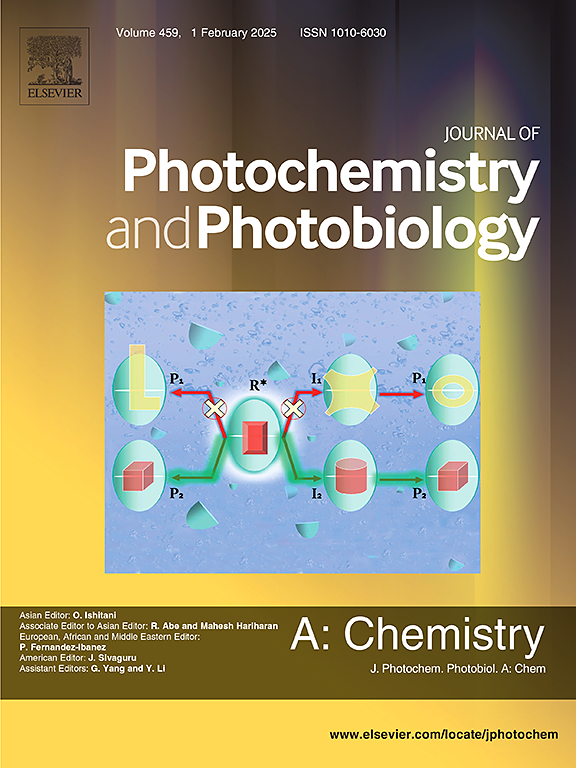利用Ru-ZnIn2S4纳米结构增强光催化制氢与四环素降解
IF 4.1
3区 化学
Q2 CHEMISTRY, PHYSICAL
Journal of Photochemistry and Photobiology A-chemistry
Pub Date : 2025-04-11
DOI:10.1016/j.jphotochem.2025.116441
引用次数: 0
摘要
采用一步水热法,在ZnIn2S4中掺杂不同量的Ru,制备了钌掺杂ZnIn2S4 (Ru-ZnIn2S4)纳米结构。采用XRD、TEM、SEM、UV-vis DRS、PL、TRPL等一系列表征方法对制备样品的结构、形貌、能带结构、光吸收及光电化学性能进行了表征。这些结果表明,在ZnIn2S4中掺入Ru可以有效地提高光电子和空穴的分离和转移效率。当RuCl3的加入量为30µmol时,光催化制氢性能达到最佳,产氢率为5974.7 μmol·g−1·h−1,是纯ZnIn2S4的15.9倍。在产氢耦合降解四环素(TC)的实验中,TC对0.03Ru-ZnIn2S4的降解率达到70.2%,产氢率高达202.8 μmol·g−1·h−1,有效地实现了TC的氢能转化和降解。本研究提出了一种光催化处理废水的新策略,实现了能量回收和废水处理。本文章由计算机程序翻译,如有差异,请以英文原文为准。

Enhanced photocatalytic hydrogen production coupled with tetracycline degradation using Ru-ZnIn2S4 nanostructures
Ru-doped ZnIn2S4 (Ru-ZnIn2S4) nanostructures were prepared by doping different amounts of Ru into ZnIn2S4 through a one-step hydrothermal method. The structure, morphology, band structure, light absorption and photoelectrochemical properties of as-prepared samples were characterized by a series of characterization methods such as XRD, TEM, SEM, UV–vis DRS, PL and TRPL. These results show that doping Ru into ZnIn2S4 effectively improves the separation and transfer efficiency of photogenerated electrons and holes. When the addition amount of RuCl3 is 30 µmol, the photocatalytic hydrogen production performance reaches its optimum, achieving a hydrogen production rate of 5974.7 μmol·g−1·h−1, which is 15.9 times greater than that of pure ZnIn2S4. In the experiment of hydrogen production coupled with tetracycline (TC) degradation, the degradation rate of TC for 0.03Ru-ZnIn2S4 reaches 70.2 %, and the hydrogen production rate reaches up to 202.8 μmol·g−1·h−1, effectively achieving the hydrogen energy conversion and degradation of TC. This study presents a novel strategy for the treatment of wastewater by photocatalysis and realization of energy recovery as well as wastewater treatment.
求助全文
通过发布文献求助,成功后即可免费获取论文全文。
去求助
来源期刊
CiteScore
7.90
自引率
7.00%
发文量
580
审稿时长
48 days
期刊介绍:
JPPA publishes the results of fundamental studies on all aspects of chemical phenomena induced by interactions between light and molecules/matter of all kinds.
All systems capable of being described at the molecular or integrated multimolecular level are appropriate for the journal. This includes all molecular chemical species as well as biomolecular, supramolecular, polymer and other macromolecular systems, as well as solid state photochemistry. In addition, the journal publishes studies of semiconductor and other photoactive organic and inorganic materials, photocatalysis (organic, inorganic, supramolecular and superconductor).
The scope includes condensed and gas phase photochemistry, as well as synchrotron radiation chemistry. A broad range of processes and techniques in photochemistry are covered such as light induced energy, electron and proton transfer; nonlinear photochemical behavior; mechanistic investigation of photochemical reactions and identification of the products of photochemical reactions; quantum yield determinations and measurements of rate constants for primary and secondary photochemical processes; steady-state and time-resolved emission, ultrafast spectroscopic methods, single molecule spectroscopy, time resolved X-ray diffraction, luminescence microscopy, and scattering spectroscopy applied to photochemistry. Papers in emerging and applied areas such as luminescent sensors, electroluminescence, solar energy conversion, atmospheric photochemistry, environmental remediation, and related photocatalytic chemistry are also welcome.

 求助内容:
求助内容: 应助结果提醒方式:
应助结果提醒方式:


